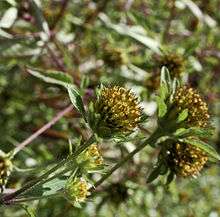Bidens frondosa
| Bidens frondosa | |
|---|---|
 | |
| Scientific classification | |
| Kingdom: | Plantae |
| (unranked): | Angiosperms |
| (unranked): | Eudicots |
| (unranked): | Asterids |
| Order: | Asterales |
| Family: | Asteraceae |
| Subfamily: | Asteroideae |
| Tribe: | Heliantheae |
| Subtribe: | Coreopsidinae |
| Genus: | Bidens |
| Species: | B. frondosa |
| Binomial name | |
| Bidens frondosa L. | |
| Synonyms[1] | |
|
Bidens melanocarpa Wiegand | |
Bidens frondosa is a North American species of flowering plant in the aster family, sunflower family. It is widespread across much of Canada, the United States, and Mexico[2][3][4] It is known in many other parts of the world as an introduced species, including Europe, Asia, Morocco, and New Zealand.[2][5][6] Its many common names include devil's beggarticks, devil's-pitchfork, devil's bootjack, sticktights, bur marigold, pitchfork weed, tickseed sunflower,[7] leafy beggarticks,[8] and common beggar-ticks.[9]
Description
Bidens frondosa is annual herb is usually about 20 to 60 (8-20 inches) centimeters tall, but it can reach 1.8 meters (72 inches or 6 feet) at times. The stems are square in cross-section and may branch near the top. The leaves are pinnate, divided into a few toothed triangular or lance-shaped leaflets usually up to 6 or 8 centimeters long, sometimes up to 12. The inflorescence is often a solitary flower head, but there may be pairs or arrays of several heads. The head contains many orange disc florets. It often lacks ray florets but some heads have a few small yellow rays. The fruit is a flat black or brown barbed cypsela up to a centimeter long which has two obvious hornlike pappi at one end.[3][8][10][11]
The barbed pappi on the fruit help it stick to animals, facilitating seed dispersal.[10]
Ecology
The defoliating caterpillar of Hadjina chinensis, which is limited to Bidens species, has been observed on this plant.[12]
Invasive species
This plant is invasive in some parts of the world. In New Zealand it is classed as an environmental weed by the Department of Conservation.[13] It is also weedy in its native range, occurring in pastures and fields and along roadsides.[10]
References
- ↑ The Plant List, Bidens frondosa L.
- 1 2 Bidens frondosa. Germplasm Resources Information Network (GRIN).
- 1 2 Bidens frondosa. Flora of North America.
- ↑ Biota of North America Program 2014 state-level distribution map
- ↑ Flora of China, 大狼杷草 da lang pa cao, Bidens frondosa Linnaeus, Sp. Pl. 2: 832. 1753.
- ↑ Altervista Flora Italiana, Forbicina fogliosa, schwarzfrüchtiger Zweizahn, Bidens frondosa L.
- ↑ Bidens frondosa. Integrated Taxonomic Information System (ITIS).
- 1 2 Bidens frondosa. Burke Museum. University of Washington.
- ↑ Bidens frondosa. Freckmann Herbarium. University of Wisconsin, Stevens Point.
- 1 2 3 Devils Beggarticks or Stick-tights: Bidens frondosa. Virginia Tech Weed Identification Guide.
- ↑ Bidens frondosa. The Jepson eFlora 2013.
- ↑ Han, Y. G., et al. (2009). Insect herbivores associated with the introduced weed Bidens frondosa L.(Asteraceae) in Korea, and their potential role as augmentative biological control agents. Entomological Research 39(6), 394-400.
- ↑ Howell, C. (May 2008). Consolidated List of Environmental Weeds in New Zealand. 292. Wellington, New Zealand: Department of Conservation. ISBN 978-0-478-14413-0.
External links
| Wikimedia Commons has media related to Bidens frondosa. |
| Wikibooks' A Wikimanual of Gardening has more about this subject: |
